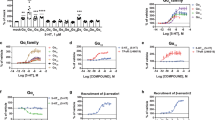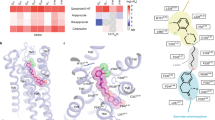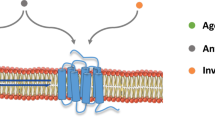Abstract
As a result of superior efficacy and overall tolerability, atypical antipsychotic drugs have become the treatment of choice for schizophrenia and related disorders, despite their side effects. Weight gain is a common and potentially serious complication of some antipsychotic drug therapy, and may be accompanied by hyperlipidemia, hypertension and hyperglycemia and, in some extreme cases, diabetic ketoacidosis. The molecular mechanism(s) responsible for antipsychotic drug-induced weight gain are unknown, but have been hypothesized to be because of interactions of antipsychotic drugs with several neurotransmitter receptors, including 5-HT2A and 5-HT2C serotonin receptors, H1-histamine receptors, α1- and α2-adrenergic receptors, and m3-muscarinic receptors. To determine the receptor(s) likely to be responsible for antipsychotic-drug-induced weight gain, we screened 17 typical and atypical antipsychotic drugs for binding to 12 neurotransmitter receptors. H1-histamine receptor affinities for this group of typical and atypical antipsychotic drugs were significantly correlated with weight gain (Spearman ρ=−0.72; p<0.01), as were affinities for α1A adrenergic (ρ=−0.54; p<0.05), 5-HT2C (ρ=−0.49; p<0.05) and 5-HT6 receptors (ρ=−0.54; p<0.05), whereas eight other receptors' affinities were not. A principal components analysis showed that affinities at the H1, α2A, α2B, 5-HT2A, 5-HT2C, and 5-HT6 receptors were most highly correlated with the first principal component, and affinities for the D2, 5-HT1A, and 5-HT7 receptors were most highly correlated with the second principal component. A discriminant functions analysis showed that affinities for the H1 and α1A receptors were most highly correlated with the discriminant function axis. The discriminant function analysis, as well as the affinity for the H1-histamine receptor alone, correctly classified 15 of the 17 drugs into two groups; those that induce weight gain and those that do not. Because centrally acting H1-histamine receptor antagonists are known to induce weight gain with chronic use, and because H1-histamine receptor affinities are positively correlated with weight gain among typical and atypical antipsychotic drugs, it is recommended that the next generation of atypical antipsychotic drugs be screened to avoid H1-histamine receptors.
Similar content being viewed by others
Log in or create a free account to read this content
Gain free access to this article, as well as selected content from this journal and more on nature.com
or
References
Allison DB, Mentore JL, Heo M, Chandler LP, Cappelleri JC, Infante MC et al (1999). Antipsychotic-induced weight gain: a comprehensive research synthesis. Am J Psychiatry 156: 1686–1696.
Altamura AC, Percudani M, Guercetti G, Invernizzi G (1989). Efficacy and tolerability of fluoxetine in the elderly: a double-blind study versus amitryptiline. Int Clin Psychopharmacol 4 (Suppl 1): 103–106.
Bolden C, Cusack B, Richelson E (1992). Antagonism by antimuscarinic and neuroleptic compounds at the five cloned human muscarinic cholinergic receptors expressed in Chinese hamster ovary cells. J Pharmacol Exper Therap 260: 576–580.
Burns CM, Chu H, Rueter SM, Hutchinson LK, Canton H, Sanders-Bush E et al (1997). Regulation of serotonin-2C receptor G-protein coupling by RNA editing. Nature 387: 303–308.
Canton H, Verriele L, Colpaert FC (1990). Binding of typical and atypical antipsychotics to 5-HT1C and 5-HT2 sites: clozapine potently interacts with 5-HT1C sites. Eur J Pharmacol 191: 93–96.
Fontaine KR, Heo M, Harrigan EP, Shear CL, Lakshminarayanan M, Casey DE et al (2001). Estimating the consequences of anti-psychotic induced weight gain on health and mortality rate. Psychiatry Res 101: 277–288.
Fukagawa K, Sakata T, Shiraishi T, Yoshimatsu H, Fujimoto K, Ookuma K et al (1989). Neuronal histamine modulates feeding behavior through H1-receptor in rat hypothalamus. Am J Physiol 256: R605–R611.
Glennon RA, Lee M, Rangisetty JB, Dukat M, Roth BL, Savage JE et al (2000). 2-Substituted tryptamines: agents with selectivity for 5-HT(6) serotonin receptors. J Med Chem 43: 1011–1018.
Herrick-Davis K, Grinde E, Teitler M (2000). Inverse agonist activity of atypical antipsychotic drugs at human 5-hydroxytryptamine2C receptors. J Pharmacol Exp Ther 295: 226–232.
Kane J, Honigfield G, Singer J, Meltzer HY, Group at CCS (1988). Clozapine for the treatment-resistant schizophrenic. Arch Gen Psychiatry 45: 789–796.
Lappalainen J, Zhang L, Dean M, Oz M, Ozaki N, Yu DH et al (1995). Identification, expression, and pharmacology of a Cys23-Ser23 substitution in the human 5-HT2c receptor gene (HTR2C). Genomics 27: 274–279.
Masaki T, Yoshimatsu H, Chiba S, Watanabe T, Sakata T (2001a). Central infusion of histamine reduces fat accumulation and upregulates UCP family in leptin-resistant obese mice. Diabetes 50: 376–384.
Masaki T, Yoshimatsu H, Chiba S, Watanabe T, Sakata T (2001b). Targeted disruption of histamine H1-receptor attenuates regulatory effects of leptin on feeding, adiposity, and UCP family in mice. Diabetes 50: 385–391.
McIntyre RS, McCann SM, Kennedy SH (2001). Antipsychotic metabolic effects: weight gain, diabetes mellitus, and lipid abnormalities. Can J Psychiatry 46: 273–281.
Meltzer HY (1999a). The role of serotonin in antipsychotic drug action. Neuropsychopharmacology 21: 106S–115S.
Meltzer HY (1999b). Suicide and schizophrenia: clozapine and the InterSePT study. International Clozaril/Leponex Suicide Prevention Trial. J Clin Psychiatry 60: 47–50.
Meltzer HY, Matsubara S, Lee J-C (1989). Classification of typical and atypical antipsychotic drugs on the basis of dopamine D-1, D-2 and serotonin2 pKi values. J Pharmacol Exper Therap 251: 238–246.
Meltzer HY, McGurk SR (1999). The effects of clozapine, risperidone, and olanzapine on cognitive function in schizophrenia. Schizophr Bull 25: 233–255.
Meltzer HY, Okayli G (1995). Reduction of suicidality during clozapine treatment of neuroleptic-resistant schizophrenia: impact on risk-benefit assessment. Am J Psychiatry 152: 183–190.
Meltzer HY, Park S, Kessler R (1999). Cognition, schizophrenia, and the atypical antipsychotic drugs. Proc Natl Acad Sci USA 96: 13591–13593.
Menon MK, Clark WG, Aures D (1971). Effect of thiazol-4-ylmethoxyamine, a new inhibition of histamine biosynthesis on brain histamine, monoamine levels and behavior. Life Sci I 10: 1097–1109.
Nguyen T, Shapiro DA, George SR, Setola V, Lee DK, Cheng R et al (2001). Discovery of a novel member of the histamine receptor family. Mol Pharmacol 59: 427–433.
Peroutka SJ, Synder SH, Snyder SH (1980). Relationship of neuroleptic drug effects at brain dopamine, serotonin, alpha-adrenergic, and histamine receptors to clinical potency. Long-term antidepressant treatment decreases spiroperidol-labeled serotonin receptor binding. Am J Psychiatry 137: 1518–1522.
Rauser L, Savage JE, Meltzer HY, Roth BL (2001). Inverse agonist actions of typical and atypical antipsychotic drugs at the human 5-hydroxytryptamine(2C) receptor. J Pharmacol Exp Ther 299: 83–89.
Reynolds GP, Zhang ZJ, Zhang XB (2002). Association of antipsychotic drug-induced weight gain with a 5-HT2C receptor gene polymorphism. Lancet 359: 2086–2087.
Roth BL, Ciaranello RD, Meltzer HY (1992). Binding of typical and atypical antipsychotic agents to transiently expressed 5-HT1C receptors. J Pharmacol Exp Ther 260: 1361–1365.
Roth BL, Craigo SC, Choudhary MS, Uluer A, Monsma Jr FJ, Shen Y et al (1994). Binding of typical and atypical antipsychotic agents to 5-hydroxytryptamine-6 and 5-hydroxytryptamine-7 receptors. J Pharmacol Exp Ther 268: 1403–1410.
Roth BL, Meltzer H, Khan N (1998). Binding of typical and atypical antipsychotic drugs to multiple neurotransmitter receptors. In: Goldstein DS, Eisen Hoffer G, Mc Carty R (eds). Advances in Pharmacology. Academic Press: San Diego, pp 482–485.
Rothman RB, Baumann MH, Savage JE, Rauser L, McBride A, Hufeisen SJ et al (2000). Evidence for possible involvement of 5-HT(2B) receptors in the cardiac valvulopathy associated with fenfluramine and other serotonergic medications. Circulation 102: 2836–2841.
Sakai N, Sakurai E, Onodera K, Asada H, Miura Y, Watanabe T (1995). Long-term depletion of brain histamine induced by alpha-fluoromethylhistidine increases feeding-associated locomotor activity in mice with a modulation of brain amino acid levels. Behav Brain Res 72: 83–88.
Sakata T, Ookuma K, Fukagawa K, Fujimoto K, Yoshimatsu H, Shiraishi T et al (1988). Blockade of the histamine H1-receptor in the rat ventromedial hypothalamus and feeding elicitation. Brain Res 441: 403–407.
Seeman P, Corbett R, van Tol HHM (1997). Atypical neuroleptics have low affinity for dopamine D2 receptors or are selective for D4 receptors. Neuropsychopharmacology 16: 93–135.
Seeman P, Lee T (1975). Antipsychotic drugs: direct correlation between clinical potency and presynaptic action on dopamine neurons. Science 188: 1217–1219.
Taylor DM, McAskill R (2000). Atypical antipsychotics and weight gain—a systematic review. Acta Psychiatr Scand 101: 416–432.
Tecott LH, Sun LM, Akana SF, Strack AM, Lowenstein DH, Dallman MF et al (1995). Eating disorder and epilepsy in mice lacking 5-HT2c serotonin receptors [see comments]. Nature 374: 542–546.
Van Tol HHM, Bunzow JR, Guan HC, Sunahara H-C, Seeman P, Niznik HB et al (1991). Cloning of the gene for a human dopamine D4 receptor with high affinity for the antipsychotic clozapine. Nature 350: 610–614.
Vickers SP, Clifton PG, Dourish CT, Tecott LH (1999). Reduced satiating effect of d-fenfluramine in serotonin 5-HT(2C) receptor mutant mice. Psychopharmacology (Berl) 143: 309–314.
Wetterling T (2001). Bodyweight gain with atypical antipsychotics. A comparative review. Drug Safety 24: 59–73.
Wood MD, Reavill C, Trail B, Wilson A, Stean T, Kennett GA et al (2001). SB-243213; a selective 5-HT2C receptor inverse agonist with improved anxiolytic profile: lack of tolerance and withdrawal anxiety. Neuropharmacology 41: 186–199.
Yamada M, Miyakawa T, Duttaroy A, Yamanaka A, Moriguchi T, Makita R et al (2001). Mice lacking the M3 muscarinic acetylcholine receptor are hypophagic and lean. Nature 410: 207–212.
Zeng XP, Le F, Richelson E (1997). Muscarinic m4 receptor activation by some atypical antipsychotic drugs. Eur J Pharmacol 321: 349–354.
Acknowledgements
WKK was supported in part by a NARSAD Young Investigator Award. Additional support was provided to BLR by the NIMH Psychoactive Drug Screening Program NO2MH80005 and by an NIMH Research Scientist Development Award KO2MH01366.
Author information
Authors and Affiliations
Corresponding author
Rights and permissions
About this article
Cite this article
Kroeze, W., Hufeisen, S., Popadak, B. et al. H1-Histamine Receptor Affinity Predicts Short-Term Weight Gain for Typical and Atypical Antipsychotic Drugs. Neuropsychopharmacol 28, 519–526 (2003). https://doi.org/10.1038/sj.npp.1300027
Received:
Accepted:
Published:
Issue date:
DOI: https://doi.org/10.1038/sj.npp.1300027
Keywords
This article is cited by
-
On the construction of LIECE models for the serotonin receptor 5-HT\(_{\text {2A}}\)R
Journal of Computer-Aided Molecular Design (2023)
-
Association of cardiovascular metabolic risk factor measurements with psychiatric readmission among in-hospital patients with severe mental illness: a retrospective study
BMC Psychiatry (2022)
-
Functional patient-derived cellular models for neuropsychiatric drug discovery
Translational Psychiatry (2021)
-
Targeting β-Arrestins in the Treatment of Psychiatric and Neurological Disorders
CNS Drugs (2021)
-
Antipsychotic-Induced Constipation: A Review of the Pathogenesis, Clinical Diagnosis, and Treatment
CNS Drugs (2021)



